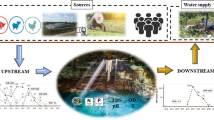Abstract
Hydromorphogeological studies have been carried out around Agnigundala mineralised belt (longitude 70°.39′ - 16°.51′ and latitude 16°.2′ - 16°.15′) using remote sensing IRS-IB and SPOT data for ground water exploration. Based on erosional and depositional characters of various geomorphic units like Hills (Structural and denudational) Pediment, Buried pediment, plains and valley fills have been identified in various lithologies like granite, granite gneiss, biotite schist, phyllite,. quartzite and dolomite. The acclamations of individual geomorphic units through visual interpretation are verified from field data. The groundwater potentials of the individual geomorphologic units have been evaluated to obtain a complete hvdrogcological picture of the area. The field data have further helped in quanlifying various geomorphological units with reference to their potential for ground water occurrence.
Similar content being viewed by others
References
Babu, V. R. R. M. (1996). Nellorc Schisl Belt, An Archaean Greenstone Belt,. Andhra Pradesh, India- A Prospective. Paper Presented at the Monthly Meeting of Geological Society of India, Bangalore. 7()p.
Chatterji, P. C. Singh, S. and Qureshi, L. H. (1978). llydrogeomorphology of the Central Luni Basin, Western Rajaslhan. India. Geo forum 9, pp. 211–214.
Gopalan, K. and Bhaskara Rao, Y. J. (1995). A Critical Appraisal of the Geological Results on the Cuddapah and Related Rocks, pp. 109-115, in Geol. Soc. Ind.. Seminar on “Cuddapah Basin”. September 9–12. 1995 at Tirupathi.
Gupta, J. N., Pandey, B. K., Chabria, T., Banerjee, D. C. and Jayaram, K. M. Y. (1984). Rb-Sr. Geochronological Studies on the Granites of Vinukonda Kanigiri, Prakasam Dist.. A.P.. India. Precambrian Res., 26:105–109.
Mangrulkar, A. D., Kondawar, V. K. and Krishna Murthy, Y.V.N. (1993). Geo-Environmental Characteristics and Identification of Hydro Potential Zones in Tansa and Bhastsai Reservoir Catchments. Journal of the Indian Society of Remote Sensing, 21(1): 127–134.
Murthy, Y. G. K. Sethi, D. N., Shashikumar. K.. Subba Rao. N. and Sagar, A. K. (1971). Geology and copper-lead mineralization in Dhukonda and Nallakonda. Agnigundala area. Guntur dist. A.P. Geological survey of India Misc. Publ. Base Metals Port, 66:208–220.
Narayana Swamy, S. (1966). Tectonics of the Cuddapah Basin, Jour. Geol. Soc. India. 7:33–50.
Prudhuvi Raju, K. N. and Vaidyanadhan, R. (1984). Photohydrogcomorphology of the Sarada River basin in Visakhapatnam district, A.P., Journal Assoc. Expl. Geophysicsts, 4(3):3l-39.
Radhakrishnan, B. P. (1964). Symposiumon Stratigraphy, Age and Correlation of Archaean Provinces of India, Summary of Proceedings, Andhra University, 33p.
Radhakrishnan, B. P. and Vasudev, V. N. (1977). The Early Precambrian of Southern India Shield, Jour, Geol. Soc. India, 18(10):525–541.
Ravi Prakash, S. and Devendra Mishra (1993), Identification of Groundwater Prospective Zones by Using Remote Sensing and Geoelectrical Methods in and Around Saindnagar Area, Dakor Block, Jalaun Dist., U.P. Photonirvachak Journal of the Indian Society of R.M.S., 21(4):216–229.
Ravindra Kumar (1985). Fundamentals of Historical Geology and Stratigraphy of India, Wiley Easten Limited, New Delhi, 84p.
Roy, A. K. and Raina, B. M. (1973). Hydrological Studies of Kotepally Catchment in Hyderabad (A. P) Based on Aerial Photographs. Inst. Symp. on Development of groundwater resources, Madras 1, 1A, pp. 13–27.
Saini, R. R. and Nathawat, M. S. (1996). Landuse Planning of Masooda Block (Ajmer District, Rajasthan) Using IRS-LI 85-11 DATA. National Symposium on Remote Sensing for Natural Resources with Special Emphasis on Water Management, University of Pune, pp. 7–9.
Sarkar, S. N. (1980). Precambrian Stratigraphy and Geochronology of Peninsular India, a Review. Ind. Jour. Earth. Sc., 7(1): 12–26.
Srirama Rao, M. and Appavadhanulu, K. (1962). Old Copper Workings of Agnigundala, Guntur District, A.P.Q. J. Geol. Min. Met. Soc. India. 24:75–82.
Thomas, A., Verma, V. K.. Sood, A., Litoria P. K. Sharma, P. K. and Ravindran, K..V. (1995). Hydrogeology of Talwandi Sabo Tehsil. Bhathinda Dist., Punjab. A Remote Sensing Approach, Indian Soc. of Remote Sensing, 23 (2):47–56.
Author information
Authors and Affiliations
About this article
Cite this article
Sankar, G.J., Rao, M.J., Rao, B.S.P. et al. Hydromorphogeology and Remote Sensing applications for groundwater exploration in agnigundala mineralised belt, Andhra Pradesh, India. J Indian Soc Remote Sens 29, 165–174 (2001). https://doi.org/10.1007/BF02989928
Received:
Revised:
Issue Date:
DOI: https://doi.org/10.1007/BF02989928




